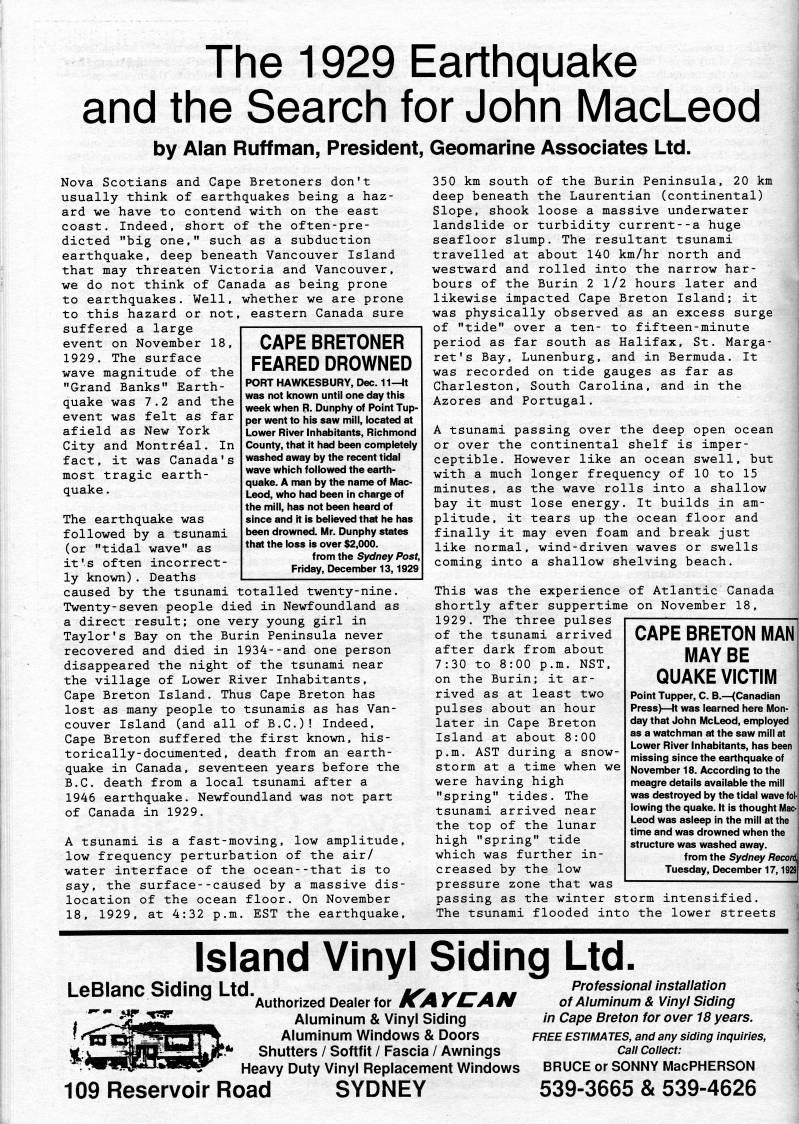Page 56 - The 1929 Earthquake and the Search for John MacLeod
Published by Ronald Caplan on 1994/8/1 (1499 reads)
 Page 55 - Through an Ocean Storm to the Fortress of Louisbourg, 1750
Page 55 - Through an Ocean Storm to the Fortress of Louisbourg, 1750
Page 57 - The 1929 Earthquake and the Search for John MacLeod

The 1929 Earthquake and the Search for John MacLeod by Alan Ruffman, President, Geomarine Associates Ltd. eastern Canada sure Nova Scotians and Cape Bretoners don't usually think of earthquakes being a haz? ard we have to contend with on the east coast. Indeed, short of the often-pre? dicted "big one," such as a subduction earthquake, deep beneath Vancouver Island that may threaten Victoria and Vancouver, we do not think of Canada as being prone to earthquakes. Well, whether we are prone to this hazard or not suffered a large event on November 18, 1929. The surface wave magnitude of the "Grand Banks" Earth? quake was 7.2 and the event was felt as far afield as New York City and Montreal. In fact, it was Canada's most tragic earth- CAPE BRETONER FEARED DROWNED PORT HAWKESBURY, Dec. 11 • It was not known until one day this week when R. Dunphy of Point Tup? per went to his saw mill, located at Lower River Inhabitants, Richmond County, that It had been completely washed away by the recent tidal wave which followed the earth? quake. A man by the name of Mac? Leod, who had been in charge of the mill, has not been heard of since and it Is believed that he has been drowned. Mr. Dunphy states that the loss is over $2,000. from the Sydney Post, Friday, December 13,1929 quake. The earthquake was followed by a tsunami (or "tidal wave" as it's often incorrect? ly known). Deaths caused by the tsunami totalled twenty-nine. Twenty-seven people died in Newfoundland as a direct result; one very young girl in Taylor's Bay on the Burin Peninsula never recovered and died in 1934--and one person disappeared the night of the tsunami near the village of Lower River Inhabitants, Cape Breton Island. Thus Cape Breton has lost as many people to tsunamis as has Van? couver Island (and all of B.C.)! Indeed, Cape Breton suffered the first known, his? torically-documented, death from an earth? quake in Canada, seventeen years before the B.C. death from a local tsunami after a 1946 earthquake. Newfoundland was not part of Canada in 1929. A tsunami is a fast-moving, low amplitude, low frequency perturbation of the air/ water interface of the ocean--that is to say, the surface--caused by a massive dis? location of the ocean floor. On November 18, 1929. at 4:32 p.m. EST the earthquake. 350 km south of the Burin Peninsula, 20 km deep beneath the Laurentian (continental) Slope, shook loose a massive underwater landslide or turbidity current--a huge seafloor slump. The resultant tsunami travelled at about 140 km/hr north and westward and rolled into the narrow har? bours of the Burin 2 1/2 hours later and likewise impacted Cape Breton Island; it was physically observed as an excess surge of "tide" over a ten- to fifteen-minute period as far south as Halifax. St. Marga? ret's Bay. Lunenburg, and in Bermuda. It was recorded on tide gauges as far as Charleston. South Carolina, and in the Azores and Portugal. A tsunami passing over the deep open ocean or over the continental shelf is imper? ceptible. However like an ocean swell, but with a much longer frequency of 10 to 15 minutes, as the wave rolls into a shallow bay it must lose energy. It builds in am? plitude, it tears up the ocean floor and finally it may even foam and break just like normal, wind-driven waves or swells coming into a shallow shelving beach. This was the experience of Atlantic Canada shortly after suppertime on November 18. 1929. The three pulses of the tsunami arrived after dark from about 7:30 to 8:00 p.m. NST. on the Burin: it ar? rived as at least two pulses about an hour later in Cape Breton Island at about 8:00 p.m. AST during a snow? storm at a time when we were having high "spring" tides. The tsunami arrived near the top of the lunar high "spring" tide which was further in? creased by the low pressure zone that was passing as the winter storm intensified. The tsunami flooded into the lower streets CAPE BRETON MAN MAYBE QUAKE VICTIM Point Tupper, C. B. • (Canadian Press) • It was learned here Mon? day that John McLeod, employed as a watchman at the saw mill at Lower River Inhabitants, has been missing since the earthquake of November 18. According to the meagre details available the mill was destroyed by the tidal wave fol? lowing the quake. It is thought Mac j Leod was asleep in the mill at the time and was drowned when the structure was washed away. from the Sydney Record Tuesday, December 17,1929( LeBlanc Siding Ltd. Island Vinyl Siding Ltd. .Mr T?r Authorized Dealer for fkM YCJkN Aluminum & Vinyl Siding Aluminum Windows & Doors Shutters / Softfit / Fascia / Awnings Heavy Duty Vinyl Replacement Windows 109 Reservoir Road SYDNEY Professional installation of Aluminum & Vinyl Siding in Cape Breton for over 18 years. FREE ESTIMATES, and any siding Inquiries, Call Collect: BRUCE or SONNY MacPHERSON 539-3665 & 539-4626
 Page 55 - Through an Ocean Storm to the Fortress of Louisbourg, 1750
Page 55 - Through an Ocean Storm to the Fortress of Louisbourg, 1750
Page 57 - The 1929 Earthquake and the Search for John MacLeod

Adobe Acrobat Reader is required to the PDF version of this content. Click here to download and install the Acrobat plugin



